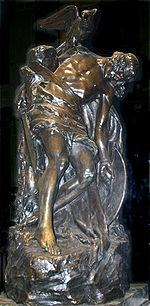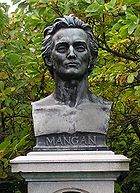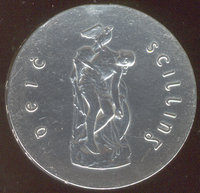
Oliver Sheppard
Encyclopedia

Royal Hibernian Academy
The Royal Hibernian Academy is an artist-based and artist-oriented institution in Ireland, founded in Dublin in 1823.-History:The RHA was founded as the result of 30 Irish artists petitioning the government for a charter of incorporation...
was an Irish
Irish people
The Irish people are an ethnic group who originate in Ireland, an island in northwestern Europe. Ireland has been populated for around 9,000 years , with the Irish people's earliest ancestors recorded having legends of being descended from groups such as the Nemedians, Fomorians, Fir Bolg, Tuatha...
sculptor, most famous for his 1911 bronze statue of the mythical Cuchullain dying in battle.
Family
Sheppard was born at CookstownCookstown
Cookstown may refer to either of the following:*Cookstown, County Tyrone, Northern Ireland*Cookstown, Ontario, Canada*Cookstown, New Jersey, United States...
, County Tyrone
County Tyrone
Historically Tyrone stretched as far north as Lough Foyle, and comprised part of modern day County Londonderry east of the River Foyle. The majority of County Londonderry was carved out of Tyrone between 1610-1620 when that land went to the Guilds of London to set up profit making schemes based on...
to artisan parents from Dublin, and he was later based in Dublin for almost all of his life, having travelled widely across Europe. His wife Rosie died in 1931, with whom he had several children. They lived at Howth
Howth
Howth is an area in Fingal County near Dublin city in Ireland. Originally just a small fishing village, Howth with its surrounding rural district is now a busy suburb of Dublin, with a mix of dense residential development and wild hillside, all on the peninsula of Howth Head. The only...
and 30 Pembroke Road in central Dublin.
Education
His main influence was the Frenchman Edouard LanteriEdouard Lanteri
Edouard Lanteri was a sculptor and medallist whose romantic French style of sculpting was seen as influential among exponents of New Sculpture.-Life history:...
who taught him at the Royal College of Art
Royal College of Art
The Royal College of Art is an art school located in London, United Kingdom. It is the world’s only wholly postgraduate university of art and design, offering the degrees of Master of Arts , Master of Philosophy and Doctor of Philosophy...
in London
London
London is the capital city of :England and the :United Kingdom, the largest metropolitan area in the United Kingdom, and the largest urban zone in the European Union by most measures. Located on the River Thames, London has been a major settlement for two millennia, its history going back to its...
, and then at the Dublin Metropolitan School of Art (DMSA) in Dublin (now the NCAD
National College of Art and Design
The National College of Art and Design is a national art and design school in Dublin, Ireland.-History:Situated on Thomas Street, the NCAD started as a private drawing school and has become a national institution educating over 1,500 day and evening students as artists, designers and art educators...
), where he later became a lecturer.
Teaching
From 1902 to 1937 Sheppard taught sculpture at the DMSA, that was renamed the National College of Art in 1936 (today the NCAD). His annual stipend was £250 but for this he only had to lecture on three mornings a week, allowing him plenty of time for work on commissioned projects.As a prominent sculptor Sheppard was a member of the Royal Hibernian Academy, the Royal Dublin Society
Royal Dublin Society
The Royal Dublin Society was founded on 25 June 1731 to "to promote and develop agriculture, arts, industry, and science in Ireland". The RDS is synonymous with its main premises in Ballsbridge in Dublin, Ireland...
, and was made a governor of the National Gallery of Ireland
National Gallery of Ireland
The National Gallery of Ireland houses the Irish national collection of Irish and European art. It is located in the centre of Dublin with one entrance on Merrion Square, beside Leinster House, and another on Clare Street. It was founded in 1854 and opened its doors ten years later...
from 1925-41.
He was generally critical of the low standards of sculpture in Ireland: "For the last sixty years or so thousands of figures and groups have been executed in Dublin for ecclesiastical purposes, and, with one or two exceptions ... was not up to a reasonable standard. The making of a work of art hardly entered into it at all. The sculptor, well trained and properly encouraged, should collaborate with the architect."
Sheppard also exhibited works at European exhibitions in his lifetime, occasionally winning prizes.
Prominent works

- 1901; imaginary statue of "Inis Fáil", seeing Ireland as an "island of destiny".
- 1905; statue of a pikemanPike (weapon)A pike is a pole weapon, a very long thrusting spear used extensively by infantry both for attacks on enemy foot soldiers and as a counter-measure against cavalry assaults. Unlike many similar weapons, the pike is not intended to be thrown. Pikes were used regularly in European warfare from the...
at WexfordWexfordWexford is the county town of County Wexford, Ireland. It is situated near the southeastern corner of Ireland, close to Rosslare Europort. The town is connected to Dublin via the M11/N11 National Primary Route, and the national rail network...
, recalling the rebels in the 1798 rebellion. - 1908 Another pikeman statue at nearby EnniscorthyEnniscorthyEnniscorthy is the second largest town in County Wexford, Ireland. The population of the town and environs is 9538. The Placenames Database of Ireland sheds no light on the origins of the town's name. It may refer either to the "Island of Corthaidh" or the "Island of Rocks". With a history going...
. - 1909; bust of the poet James Clarence ManganJames Clarence ManganJames Clarence Mangan, born James Mangan was an Irish poet.-Early life:Mangan was the son of a former hedge school teacher who took over a grocery business and eventually became bankrupt....
in St Stephen's Green, Dublin. - 1911; The "Dying Cuchulain" is Sheppard's most iconic piece, inspired in part by the success of "Cuchulain of Muirthemne", the translation by Lady Gregory of most of the Tain saga that was published in 1902.
- 1920; war memorials for the Irish solicitors and barristers who had died in the First World War (1914–18).
- 1922, bronze plaque in memory of Dr. James LittleJames Little (physician)Dr. James Little was an eminent Irish medical practitioner. After spending an early part of his career as a ship's surgeon, surviving a shipwreck, he became chief physician at the Adelaide Hospital in Dublin and Regius Professor of Physic at the University of Dublin.-Early life:Little was born in...
at the Royal College of Physicians of IrelandRoyal College of Physicians of IrelandThe Royal College of Physicians of Ireland , was founded in 1654 and is a postgraduate medical organisation comprising Members and Fellows...
. - 1926; bust of his lifelong friend George RussellGeorge William RussellGeorge William Russell who wrote under the pseudonym Æ , was an Irish nationalist, writer, editor, critic, poet, and painter. He was also a mystical writer, and centre of a group of followers of theosophy in Dublin, for many years.-Organisor:Russell was born in Lurgan, County Armagh...
, best known as "Æ". - 1930; busts of John JolyJohn JolyJohn Joly FRS was an Irish physicist, famous for his development of radiotherapy in the treatment of cancer...
at Trinity College Dublin and the Royal Dublin Society. - 1935; Aida, a bust now at the Crawford Gallery in Cork.
- 1935; Installation of The "Dying Cuchulain" at the GPOGeneral Post Office (Dublin)The General Post Office ' in Dublin is the headquarters of the Irish postal service, An Post, and Dublin's principal post office...
, Dublin, that had been the rebels' headquarters in 1916, at the request of Éamon de ValeraÉamon de ValeraÉamon de Valera was one of the dominant political figures in twentieth century Ireland, serving as head of government of the Irish Free State and head of government and head of state of Ireland...
, President of the Executive CouncilPresident of the Executive Council of the Irish Free StateThe President of the Executive Council of the Irish Free State was the head of government or prime minister of the Irish Free State which existed from 1922 to 1937...
(prime minister) at that time. The statue has had a continuing impact, and in 1966 a 50th anniversary commemoration special coin was struck with an image of it.

Political influence and opinion
Sheppard was in the minority of Irish Protestants who supported independence, starting with support for the Irish Parliamentary PartyIrish Parliamentary Party
The Irish Parliamentary Party was formed in 1882 by Charles Stewart Parnell, the leader of the Nationalist Party, replacing the Home Rule League, as official parliamentary party for Irish nationalist Members of Parliament elected to the House of Commons at...
in the 1880s, when he was an art student.
In 1890-1910 he was a part of the Celtic Revival
Celtic Revival
Celtic Revival covers a variety of movements and trends, mostly in the 19th and 20th centuries, which drew on the traditions of Celtic literature and Celtic art, or in fact more often what art historians call Insular art...
movement, and, from his works such as Inis Fáil, was admired by his student William Pearse. Through him he met his brother Patrick Pearse
Patrick Pearse
Patrick Henry Pearse was an Irish teacher, barrister, poet, writer, nationalist and political activist who was one of the leaders of the Easter Rising in 1916...
who later helped launch the Easter Rising
Easter Rising
The Easter Rising was an insurrection staged in Ireland during Easter Week, 1916. The Rising was mounted by Irish republicans with the aims of ending British rule in Ireland and establishing the Irish Republic at a time when the British Empire was heavily engaged in the First World War...
in 1916. While most of the Revival's artists were writers, playwrights and poets, Sheppard could claim to be the main sculptor working on themes similar to theirs.
After the Anglo-Irish war (1919–21) he said: "They thought me too old to fight but I have tried to help in other ways. My politics are simple. I have always thought that this country should be a free country."
Sheppard's opinions were not overly dogmatic, considering his work on the war memorials in 1920.

